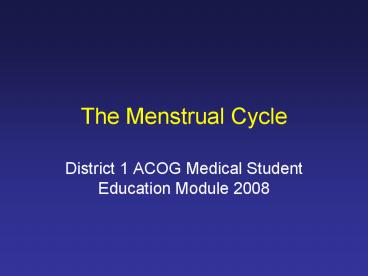The Menstrual Cycle - PowerPoint PPT Presentation
1 / 14
Title:
The Menstrual Cycle
Description:
Ovulation occurs as increase in LH level causes the follicle to rupture and release mature ovum ... Takes 3-4 days for ovum to travel down tube to the uterus ... – PowerPoint PPT presentation
Number of Views:845
Avg rating:3.0/5.0
Title: The Menstrual Cycle
1
The Menstrual Cycle
- District 1 ACOG Medical Student Education Module
2008
2
From Up to Date The Normal Menstrual Cycle
2008
3
The Menstrual Cycle Two Phases
- Ideally 14 days each
- Follicular and Luteal
- Describe changes in the ovary
- Proliferative and Secretory
- Describe changes in the endometrium
4
Hormones in the Menstrual Cycle
From Up to Date The Normal Menstrual Cycle
2008
5
Follicular phase
- Begins with the onset of menses and ends on the
day of the luteinizing hormone (LH) surge - During late luteal phase/ early follicular phase
- withdrawal of estrogen and progesterone in late
luteal phase - In early follicular phase, ovary is least
hormonally active ? low serum estradiol and
progesterone - release from negative feedback effects of
estrogen progesterone ? increase in GnRH pulse
frequency in early follicular phase - Increased GnRH pulse ? 30 increase in serum FSH
concentrations - FSH release from the pituitary stimulates growth
of 5-15 primordial follicles - By late follicular phase, a single dominant
follicle has been selected.
6
Follicular Phase
- The developing dominant follicle produces
estrogen in a 2-cell process - Theca interna cells produce androstenedione in
response to LH stimulation - Granulosa cells convert androstenedione ?
estradiol when stimulated by FSH - Estrogen causes the uterine lining to thicken /
proliferate - GnRH pulse frequency increase? rise in LH
- Rise in LH also stimulates androgen synthesis ?
androgens are converted to estrogens
7
Follicular Phase
- Serum estradiol concentrations peak approximately
1 day before ovulation - Midcycle (day 14) there is an LH spike in
response to this estrogen surge - Ovulation occurs as increase in LH level causes
the follicle to rupture and release mature ovum
8
LH Surge
- Involves a poorly-understood neuroendocrine
phenomenon in which there is a switch from
negative feedback control of LH secretion by
estradiol and progesterone to positive feedback - Rising estradiol levels at the end of the
follicular phase result in a 10-fold increase in
serum LH concentration
9
LH Surge Effect on the Ovary
- In response to LH
- Oocyte in the dominant follicle completes 1st
meiotic division - Increase in local secretion of plasminogen
activator and cytokines required for ovulation - Oocyte released from follicle at ovarian surface
36 hrs after LH surge. - Even before oocyte is released, granulosa cells
around it begin to luteinize and produce
progesterone. Progesterone slows LH pulses/
decreases LH pulse frequency
10
Ovulation
- LH spike stimulates ovulation, the release of the
ovum from the follicle - After ovulation, the luteal phase begins, and
remnants of the follicle left behind in the ovary
develop into the corpus luteum
11
Ovulation
- Ovum usually passes into adjoining fallopian tube
and is swept down to the uterus by the cilia
lining the tube - Takes 3-4 days for ovum to travel down tube to
the uterus - Fertilization must occur within 24 hrs of
ovulation or ovum degenerates
12
Luteal Phase
- After ovulation, granulosa and theca interna
cells lining the wall of the follicle form the
corpus luteum cyst (stimulated by LH) - The corpus luteum synthesizes estrogen and large
amounts of progesterone - ? Progesterone stimulates the endometrium to
become more glandular/secretory in preparation
for implantation of fertilized ovum
13
Luteal Phase
- If fertilization occurs
- developing trophoblast synthesizes human
chorionic gonadotropin (hcg) - hcg maintains the corpus luteum so it may
continue producing estrogen and progesterone to
support the endometrium - By 8-10 weeks gestation, the placenta is
developed, and takes over production of estrogen
and progesterone
14
Luteal Phase
- If fertilization does not occur
- corpus luteum is not maintained by hcg
- Corpus luteum degenerates after 14 days
- Estrogen and progesterone levels fall
- Withdrawal of progesterone causes secretory
endometrium to slough - FSH levels slowly rise again in absence of
negative feedback - ?
- MENSTRUATION






















![[DOWNLOAD]⚡️PDF✔️ Period Power: Harness Your Hormones and Get Your Cycle Working For You PowerPoint PPT Presentation](https://s3.amazonaws.com/images.powershow.com/10094680.th0.jpg?_=20240809086)








